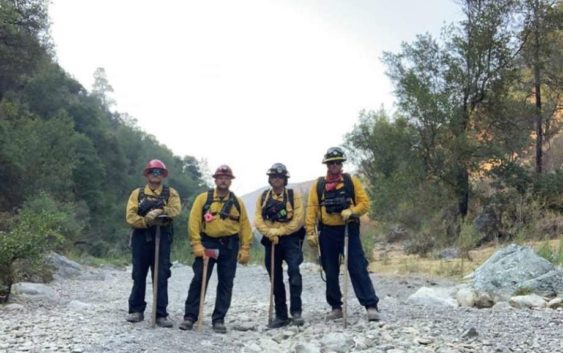- McDowell County wildfire spreads to 500 acres, evacuation orders in place
- Evacuations in Caldwell County due to wildfire
- Northwest Houston 'ghost neighborhood' caused by repeated flooding to become latest detention basin
- NHL playoffs: Hurricanes open playoffs Easter Sunday afternoon vs. Devils
- 2 wildfires spreading in rugged terrain in western North Carolina
Schertz firefighters help battle California wildfires

-
Fighting fires in the California wilderness are Schertz firefighters Carl Schultze (from left), Myron Boerger, Mack Melancon and Justin Schwersinske.
Fighting fires in the California wilderness are Schertz firefighters Carl Schultze (from left), Myron Boerger, Mack Melancon and Justin Schwersinske.
Photo: Photo Courtesy Schertz Fire Department
Fighting fires in the California wilderness are Schertz firefighters Carl Schultze (from left), Myron Boerger, Mack Melancon and Justin Schwersinske.
Fighting fires in the California wilderness are Schertz firefighters Carl Schultze (from left), Myron Boerger, Mack Melancon and Justin Schwersinske.
Photo: Photo Courtesy Schertz Fire Department
Teams of firefighters are shuttling between their fire stations in Schertz and firefighting duty in California, where wildfires continue to burn out of control.
Schertz Fire Chief Cade Long returned Sept. 18 from a week at the Creek Fire scene outside of Fresno, Calif., where several other Schertz firefighters either are stationed or have served and already returned.
Schertz firefighters are helping to tackle some of the worst blazes in California. The Creek Fire began Sept. 4 and has consumed 302,870 acres and destroyed 855 structures, with one firefighting fatality.
The August Complex Fire near Willits was sparked by lightning on Aug. 17. The blaze about 100 miles northwest of Sacramento has spread across 873,100 acres in the Mendocino National Forest area.
“There’s just smoky conditions from several of the towns, and a 120-square-mile radius was just blanketed in thick, choking smoke,” Long said after his return.
Four Schertz firefighters — Carl Schultze, Mack Melancon, Myron Boerger, and Justin Schwersinske — were among the first strike force sent from Texas through the Texas Intrastate Mutual Aid System (TISMUS), which answered the California Emergency Management Agency’s request for aid.
“We started getting notified about Aug. 22 where they first needed help,” Long said. “More than 350 lightning strikes started hundreds of fires and they all converged into one big fire.”
Texas was unable to respond in full force to the first round of calls from California due to the state reserving its manpower to help with two hurricanes predicted to hit its own shores. TISMUS was able on Aug. 24 to send its first strike force of 40 crew members — including the four Schertz firefighters. The Schertz foursome was split between the two fires.
“After we got through the hurricanes and additional fires had started out there, California made a second request,” Long said, for several hundred extra firefighters.
That second request came Sept. 10. Gov. Greg Abbott’s office approved it and the Texas Department of Emergency Management approved it on the morning of Sept. 11.
“It was approved at about 10 a.m. and by noon, all the crews were on the road and I was on a plane,” he said. “As soon as it was approved, I bought a plane ticket and was on a plane at noon on the way to Sacramento.”
Ten strike teams with about 200 firefighters deployed at the same time as Long, driving the necessary trucks and equipment that would be needed once they arrived.
“What I was doing was helping direct those crews,” Long said. “They literally find out while they are driving where they would be reporting.” As an administrator, Long’s shift lasted seven days — the limit for fire chiefs and administrators to be away from their home departments.
“When we got there, both of them (August Complex and Creek fires) were less than 20 percent contained,” he said.
As of Sept. 27, the Creek Fire is 39 percent contained and the August Complex Fire is 43 percent contained.
Even though firefighters are deployed by strike force, sometimes their daily duty varies.
“Each day is different,” Long said. “It all depends upon the division supervisor when you get your assignment each morning, at the start of the shift. It’s all very weather-dependent as well.”
The first deployed Schertz crew came home in a “crew swap” with Long and others. Their initial 14-day assignment was extended an additional seven days so they got to come home on Sept. 11. The strike force members dispatched with Long were due back Monday or Tuesday (Sept. 28 -29).
“Some of them out there now will be coming back Monday or Tuesday. Others will be going out from Texas on Monday and Tuesday, another crew swap,” he added.
Long said he was unsure whether he or his firefighters who had returned might get called back.
“A lot of the fires aren’t real contained, but they’ve managed to stop the spread of some of the big ones,” he said.
A lot of what the crews do, he said, is fight fire with fire.
“(Strike forces) may get off to the side, or ahead, of the fire, so they cut down trees or clear out,” he said. “Sometimes they will burn out that area in advance of a fire so when the fire gets there, there’s no fuel load for it to pick up on,” he added.
Long said he is not sure how many more TISMUS strike forces may be formed to aid California in this record-setting fire season.
jflinn@express-news.net